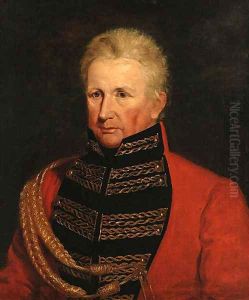Sir William Beechy Paintings
Sir William Beechey was a prominent English portrait painter who gained significant recognition during his lifetime for his work, particularly for his royal portraits. Born on December 12, 1753, in Burford, Oxfordshire, Beechey showed an early interest in art. He initially trained with a local solicitor in Warwickshire, but his passion for painting led him to abandon a career in law. He then moved to London and became a student at the Royal Academy Schools in 1772, where he studied under Johan Zoffany and developed his skills in portraiture.
Beechey's career began to flourish in the 1780s after he established himself as a portraitist in Norwich and later in London. He was adept at capturing the likeness and character of his sitters, which ranged from middle-class patrons to the most notable figures of his time. In 1793, he was appointed as the portraitist of Queen Charlotte and became the official court portrait painter. His work was well-received, and in 1798 he was knighted by King George III, which was an acknowledgment of his contribution to the arts and his status as a favored artist of the royal family.
Throughout his career, Beechey exhibited extensively at the Royal Academy and was elected as an Associate member in 1793 and a full Academician in 1798. His portraits were characterized by their elegance and grace, often set against landscape or architectural backgrounds. Beechey's style was influenced by the grand manner of Joshua Reynolds, but he also incorporated a more personal and naturalistic touch, which added to the appeal of his paintings.
Sir William Beechey continued to paint until his later years, enjoying the patronage of a wide array of clients. He produced a vast body of work, which included individual and family portraits, as well as official portraits of military figures and aristocrats. Beechey's legacy as a portraitist is marked by the extensive collection of his paintings that can be found in galleries and private collections around the world. He passed away on January 28, 1839, leaving behind a rich legacy as one of England's foremost portrait painters of the late 18th and early 19th centuries.
